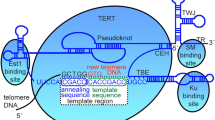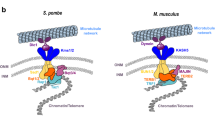Abstract
In most eukaryotes the telomeres consist of short DNA tandem repeats and associated proteins. Telomeric repeats are added to the chromosome ends by telomerase, a specialized reverse transcriptase. We examined telomerase activity and telomere repeat sequences in representatives of basal metazoan groups. Our results show that the ‘vertebrate’ telomere motif (TTAGGG) n is present in all basal metazoan groups, i.e. sponges, Cnidaria, Ctenophora, and Placozoa, and also in the unicellular metazoan sister group, the Choanozoa. Thus it can be considered the ancestral telomere repeat motif of Metazoa. It has been conserved from the metazoan radiation in most animal phylogenetic lineages, and replaced by other motifs–according to our present knowledge–only in two major lineages, Arthropoda and Nematoda.
Similar content being viewed by others
References
Ahn IY, Winter CE (2006) The genome of Oscheius tipulae: determination of size, complexity, and structure by DNA reassociation using fluorescent dye. Genome 49: 1007–1015.
Biessmann H, Mason JM (2003) Telomerase-independent mechanisms of telomere maintenance. Cell Mol Life Sci 60: 2325–2333.
Blair JE, Hedges SB (2005) Molecular clocks do not support the Cambrian explosion. Mol Biol Evol 22: 387–390.
Bourlat SJ, Juliusdottir T, Lowe CJ et al. (2006) Deuterostome phylogeny reveals monophyletic chordates and the new phylum Xenoturbellida. Nature 444: 85–88.
Castro LFC, Holland PWH (2002) Fluorescent in situ hybridisation to amphioxus chromosomes. Zool Sci 19: 1349–1353.
Dellaporta S, Xu A, Sagasser S et al. (2006) Mitochondrial genome of Trichoplax adhaerens supports Placozoa as the basal lower metazoan phylum. Proc Natl Acad Sci USA 103: 8751–8756.
Fajkus J, Sýkorová E, Leitch A (2005) Telomeres in evolution and evolution of telomeres. Chromosome Res 13: 469–479.
Frydrychová R, Grossmann P, Trubač P, Vítková M, Marec F (2004) Phylogenetic distribution of TTAGG telomeric repeats in insects. Genome 47: 163–178.
Giribet G (2002) Current advances in the phylogenetic reconstruction of metazoan evolution: a new paradigm for the Cambrian explosion? Mol Biol Evol 24: 345–357.
Halanych KM (2004) The new view of animal phylogeny. Annu Rev Ecol Evol Syst 35: 229–256.
Henning KA, Moskowitz N, Ashlock MA, Liu PP (1998) Humanizing the yeast telomerase template. Proc Natl Acad Sci USA 95: 5667–5671.
Hirai H, LoVerde PT (1996) Identification of the telomeres on Schistosoma mansoni chromosomes by FISH. J Parasitol 82: 511–512.
Holterman M, van der Wurff A, van den Elsen S et al. (2006) Phylum-wide analysis of SSU rDNA reveals deep phylogenetic relationships among nematodes and accelerated evolution toward crown clades. Mol Biol Evol 23: 1792–1800.
Ijdo JW, Wells RA, Baldini A, Reeders ST (1991) Improved telomere detection using a telomere repeat probe (TTAGGG) n generated by PCR. Nucleic Acids Res 19: 4780.
Imsiecke G, Pascheberg U, Mueller WEG (1993) Preparation and karyotype analysis of mitotic chromosomes of the freshwater sponge Spongilla lacustris. Chromosoma 102: 724–727.
Jha AN, Dominiquez I, Balajee AS, Hutchinson TH, Dixon DR, Natarajan AT (1995) Localization of a vertebrate telomeric sequence in the chromosomes of two marine worms (phylum Annelida, class Polychaeta). Chromosome Res 3: 507–508.
Joffe BI, Solovei IV, Macgregor HC (1998) Ends of chromosomes in Polycelis tenuis (Platyhelminthes) have telomere repeat TTAGGG. Chromosome Res 4: 323–324.
Keeling P, Burger G, Durnford DG et al. (2005) The tree of eukaryotes. Trend Ecol Evol 20: 670–676.
Kim NW, Piatyscek MA, Prowse KR et al. (1994) Specific association of human telomerase activity with immortal cells and cancer. Science 266: 2011–2015.
Kirk KE, Harmon BP, Reichardt IK, Sedat JW, Blackburn EH (1997) Block in anaphase separation caused by a telomerase template mutation. Science 275: 1478–1481.
Klapper W, Singh KK, Heidorn K, Parwaresch R, Krupp G (1998) Regulation of telomerase activity in quiescent immortalized human cells. Biochim Biophys Acta 1442: 120–126.
Koziol C, Borojevic R, Steffen R, Müller WEG (1998) Sponges (Porifera) model systems to study the shift from immortal to senescent somatic cells. Mech Ageing Dev 100: 107–120.
Laird DJ, Weissman IL (2004) Telomerase maintained in self-renewing tissues during serial regeneration of the urochordate Bothryllus schosserii. Dev Biol 273: 185–194.
Lang BF, O’Kelly C, Nerad T, Gray MW, Burger G (2002) The closest unicellular relatives of animals. Curr Biol 12: 1773–1778.
Makino S (1951) An Atlas of the Chromosome Numbers in Animals. Ames, Iowa: Iowa State College Press.
McEachern MJ, Blackburn EH (1995) Runaway telomere elongation caused by telomerase RNA gene mutations. Nature 376: 403–409.
McEachern MJ, Krauskopf A, Blackburn EH (2000) Telomeres and their control. Annu Rev Genet 34: 331–358.
Meyne J, Ratliff RL, Moyzis RK (1989) Conservation of the human telomere sequence (TTAGGG) n among vertebrates. Proc Natl Acad Sci USA 86: 7049–7053.
Moyzis RK, Buckingham JM, Cram LS et al. (1988) A highly conserved repetitive DNA sequence, (TTAGGG) n , present at the telomeres of human chromosomes. Proc Natl Acad Sci USA 85: 6622–6626.
Muller F, Wicky C, Spicher A, Tobler H (1991) New telomere formation after developmentally regulated chromosomal breakage during the process of chromatin diminution in Ascaris lumbricoides. Cell 67: 815–822.
Murchie AI, Lilley DMJ (1994) Tetraplex folding of telomere sequences and the inclusion of adenine bases. EMBO J 13: 993–1001.
Niedermaier J, Moritz KB (2000) Organization and dynamics of satellite and telomere DNAs in Ascaris: implications for formation and programmed breakdown of compound chromosomes. Chromosoma 109: 439–452.
Okazaki S, Tsuchida K, Maekawa H, Ishikawa H, Fujiwara H (1993) Identification of a pentanucleotide telomeric sequence, (TTAGG) n in the silkworm Bombyx mori and in other insects. Mol Cell Biol 13: 1424–1432.
Osanai M, Kojima KK, Futahashi R, Yaguchi S, Fujiwara H (2006) Identification and characterization of the telomerase reverse transcriptase of Bombyx mori (silkworm) and Tribolium castaneum (flour beetle). Gene 376: 281–289.
Philippe H, Snell EA, Bapteste E, Lopez P, Holland PWH, Casane D (2004). Phylogenomics of eukaryotes: impact of missing data on large alignments. Mol Biol Evol 21: 1740–1752.
Philippe H, Lartillot N, Brinkmann H (2005) Multigene analyses of bilaterian animals corroborate the monophyly of Ecdysozoa, Lophotrochozoa, and Protostomia. Mol Biol Evol 22: 1246–1253.
Pich U, Fuchs J, Schubert I (1996) How do Alliaceae stabilize their chromosome ends in the absence of TTTAGGG sequences? Chromosome Res 4: 207–213.
Plohl M, Prats E, Martinez-Lage A, Gonzalez-Tizon A, Mendez J, Cornudella L (2002) Telomeric localization of the vertebrate-type hexamer repeat, (TTAGGG) n , in the wedgeshell clam Donax trunculus and other marine invertebrate genomes. J Biol Chem 277: 19839–19846.
Prescott J, Blackburn EH (2000) Telomerase RNA template mutations reveal sequence-specific requirements for the activation and repression of telomerase action at telomeres. Mol Cell Biol 20: 2941–2948.
Rokas A, Krüger D, Carroll SB (2005) Animal evolution and the molecular signature of radiations compressed in time. Science 310: 1933–1938.
Rosén M, Edström J (2000) DNA structures common for chironomid telomeres terminating with complex repeats. Insect Mol Biol 9: 341–347.
Sahara K, Marec F, Traut W (1999) TTAGG telomeric repeats in chromosomes of some insects and other arthropods. Chromosome Res 7: 449–460.
Sasaki T, Fujiwara H (2000) Detection and distribution patterns of telomerase activity in insects. Eur J Biochem 267: 3025–3031.
Sinclair CS, Richmond RH, Ostrander GK (2007) Characterization of the telomere regions of scleractinian coral, Acropora surculosa. Genetica 129: 227–233.
Steenkamp ET, Wright J, Baldauf SL (2006) The protistan origins of animals and fungi. Mol Biol Evol 23: 93–106.
Teixeira MT, Gilson E (2005) Telomere maintenance, function and evolution: the yesast paradigm. Chromosome Res 13: 535–548.
Vítková M, Král J, Traut W, Zrzavý J, Marec F (2005) The evolutionary origin of insect telomeric repeats, (TTAGG) n . Chromosome Res 13: 145–156.
Vitturi R, Colomba MS, Gianguzza P, Pirrone AM (2000a) Chromosomal location of ribosomal DNA (rDNA), (GATA) n and (TTAGGG) n telomeric repeats in the neogastropod Fasciolaria lignaria (Mollusca: Prosobranchia). Genetica 108: 253–257.
Vitturi R, Gianguzza P, Colomba MS, Jensen KR, Riggio S (2000b) Cytogenetics in the sacoglossan Oxynoe olivacea (Mollusca: Opisthobranchia): karyotype, chromosome banding and fluorescent in situ hybridization. Marine Biol 137: 577–582.
Vitturi R, Libertini A, Armetta F, Sparacino L, Colomba MS (2002) Chromosome analysis and FISH mapping of ribosomal DNA (rDNA), telomeric (TTAGGG) n and (GATA) n repeats in the leech Haemopis sanguisuga (L.) (Annelida: Hirudinea). Genetica 115: 189–194.
Walter MF, Bozorgnia L, Maheshwari A, Biessmann H (2001) The rate of terminal nucleotide loss from a telomere of the mosquito Anopheles gambiae. Insect Mol Biol 10: 105–110.
Wang YP, Guo XM (2001) Chromosomal mapping of the vertebrate telomeric sequence (TTAGGG) n in four bivalve molluscs by fluorescence in situ hybridization. J Shellfish Res 20: 1187–1190.
Weichenhan D (1991) Fast recovery of DNA from agarose gels by centrifugation through blotting paper. Trends Genet 7: 109.
Yu GL, Bradley JD, Attardi LD, Blackburn EH (1990) In vivo alteration of telomere sequences and senescence caused by mutated Tetrahymena telomerase RNAs. Nature 344: 126–132.
Zacharias H, Anokhin B, Khalturin K, Bosch TCG (2004) Genome sizes and chromosomes in the basal metazoan Hydra. Zoology 107: 219–227.
Zakian VA (1995) Telomeres: beginning to understand the end. Science 270: 1601–1607.
Author information
Authors and Affiliations
Corresponding author
Rights and permissions
About this article
Cite this article
Traut, W., Szczepanowski, M., Vítková, M. et al. The telomere repeat motif of basal Metazoa. Chromosome Res 15, 371–382 (2007). https://doi.org/10.1007/s10577-007-1132-3
Received:
Revised:
Accepted:
Published:
Issue Date:
DOI: https://doi.org/10.1007/s10577-007-1132-3




